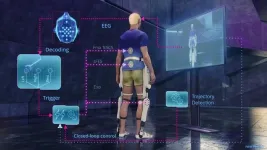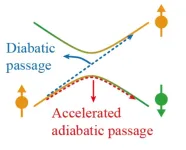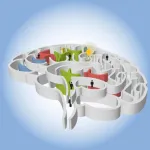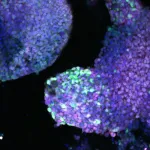(Press-News.org) An estimated 1.8 million incarcerated people in the United States have been recently exposed to a dangerous combination of heat and humidity, and on average experience 100 days of these conditions each year—many of them in the 44 states that do not provide universal air conditioning to inmates. Tracking with climate change, in recent decades, the number of dangerous humid heat days in carceral facilities has increased, with those in the south experiencing the most rapid warming.
The findings by researchers at Columbia University Mailman School of Public Health, Montana State University, University of Kansas and University of California, Los Angeles (UCLA) appear in the journal Nature Sustainability.
“Exposure to excess heat and humidity can lead to deadly heat stroke and kidney disease from chronic dehydration, among other health issues, for incarcerated people in the United States,” says first author Cascade Tuholske, PhD, assistant professor of Human-Environment Geography at Montana State University. “The majority of these exposures are happening in state-run prisons and jails in Southern states that do not legally mandate access to air conditioning for the incarcerated. It is concerning because climate change is amplifying dangerous heat extremes in these locations.”
“Dangerous heat impacting incarcerated people has been largely ignored, in part due to perceptions that their physical suffering is justified,” says senior author Robbie M. Parks, PhD, assistant professor of Environmental Health Sciences at Columbia University Mailman School of Public Health. “Laws mandating safe temperature ranges, enhanced social and physical infrastructure, and focused health system interventions could mitigate the problem. Doing so is critical for incarcerated people, who have severely limited social and political agency.”
Additional findings:
More than half of all dangerous heat and humidity exposures in the U.S. took place in Florida and Texas. The estimated 145,240 people in Texas and 98,941 in Florida housed in state-run carceral facilities in 2018—together 12 percent of all incarcerated people in the U.S.—accounted for 52 percent of exposure (28 percent in TX, 24 percent in FL).
The worst facilities experienced dangerous heat and humidity between one-fifth and one-third of the year. An estimated 118 carceral facilities—largely in southern California, Arizona, Texas, and inland Florida—experienced on average 75 days or more per year of dangerous humid heat. The Starr County Jail in Rio Grande Texas that incarcerated an estimated 249 people in 2018 experienced the largest number of dangerous humid heat days on average during 2016 to 2020: 126.2 days per year.
Areas with jails and prisons experienced 5.5 more dangerous humid heat days annually compared to other locations without carceral facilities. Carceral facilities in Arizona experienced 13.1 more days per year than the rest of the state and 40.9 more days compared to the entire continental U.S. during 1982-2020, on average. Carceral facilities are often built in areas with greater heat and humidity.
Nearly a million incarcerated people are housed in facilities seeing an increase in dangerous humidity and heat. An estimated 915,627 people in the U.S.—45 percent of the estimated total incarcerated population—were housed in 1,739 carceral facilities with an annual increase in the number of dangerous days. Carceral facilities in Florida experienced on-average 22.1 more days in 2020 compared to 1982, the greatest increase in dangerous humid heat days for all continental states.
Incarcerated people are disproportionately susceptible to dangerous humid heat given preexisting health conditions. In fact, 43 percent of the state prison population has a previous mental health diagnosis, and people on psychotropic medications are at increased risk for heat illness.
The researchers estimated heat and humidity using data from the PRISM Climate Group across in 4,078 facilities nationwide with data from the U.S. Department of Homeland Security. Dangerous days were those where the indoor wet bulb globe temperature—a measure of humid-heat stress—exceeded 82.4 degrees Fahrenheit (28°C)—the threshold used by the U.S. National Institute for Occupational Safety and Health to limit humid heat exposure under moderate workloads.
Additional co-authors include Victoria D. Lynch, Raenita Spriggs, and Anne E. Nigra of Columbia Mailman School of Public Health, Yoonjung Ahn of University of Kansas, and Colin Raymond of UCLA.
Funding support for the study was provided by the National Aeronautics and Space Administration (80NSSC22K1872), National Institutes of Health (R00ES033742, DP5OD031849, P2CHD058486, T32ES007322).
The authors declare no competing interests.
END
Hazardous heat and humidity is widespread in US jails and prisons, and climate change is worsening conditions
2024-03-05
ELSE PRESS RELEASES FROM THIS DATE:
8 in 10 lizards could be at risk due to deforestation
2024-03-05
In Colorado, people flock to the Rocky Mountains when the summer heat gets unbearable. Animals seek shelter too when temperatures become extreme, and forests serve as critical sanctuaries for small tree-dwelling animals like lizards.
In a new study published March 5 in the journal Nature Climate Change, scientists from the University of Colorado Boulder and Tel Aviv University in Israel revealed that deforestation combined with climate change could negatively impact 84% of North America’s lizards by ...
Major neurotech hub in Milan announced
2024-03-05
The IRCCS San Raffaele Hospital and the Vita-Salute San Raffaele University announced the launch of a long-term partnership with the recently established Nicolelis Institute for Advanced Brain Studies of the Brazilian Alberto Santos Dumont Association for Research Support (AASDAP, www.aasdap.org.br) aimed at creating a state-of-the-art Neurotech Hub on their campus in the city of Milan. Resulting from a two-year planning process, that included the development of a comprehensive Master Plan, the San Raffaele Neurotech Hub will be the first initiative of this kind in Europe focused on deploying ...
Special insecticide paint may help curb zika and dengue fever outbreaks
2024-03-05
Malaria and other illnesses caused by parasites, viruses, and bacteria transmitted by organisms that spread infectious pathogens account for more than 17% of all infectious diseases worldwide. These vector-borne diseases, typically transmitted by insects like mosquitoes, flies, and ticks, disproportionally affect the poorest populations in tropical and subtropical regions.
In Cabo Verde, an island nation off west Africa, vector-borne disease has been prevalent for centuries, in part due to the island’s geographical location ...
Shortcut to Success: Toward fast and robust quantum control through accelerating adiabatic passage
2024-03-05
Osaka, Japan – Researchers at Osaka University’s Institute of Scientific and Industrial Research (SANKEN) used the shortcuts to the adiabaticity (STA) method to greatly speed-up the adiabatic evolution of spin qubits. The spin flip fidelity after pulse optimization can be as high as 97.8% in GaAs quantum dots. This work may be applicable to other adiabatic passage and will be useful for fast and high-fidelity quantum control.
A quantum computer uses the superposition of “0” and “1” states to perform information processing, which is completely different from classical computing, thus allowing for the solution of certain problems at a much faster rate. High-fidelity ...
Gen Z’s climate anxiety is real and needs action — for everyone’s wellbeing
2024-03-05
New Curtin University research has shown Australian young people have major concerns about climate change, which is having a significant impact on their lives and could have broader consequences decades into the future.
Published in Sustainable Earth Reviews, the study surveyed Australian university students belonging to Generation Z (people born between 1995 and 2010) and found climate change was their number one environmental concern.
More than 80 per cent reported being ‘concerned’ or ‘very concerned’ about climate change, with many revealing they felt anxious over the issue.
Climate anxiety ...
Proposals for cell donation procedures to create brain organoids
2024-03-05
With advances in neuroscience and the development of new technologies, new ethical considerations have emerged. This is particularly true for human brain organoids, which are three-dimensional tissues grown from stem cells that partially replicate the characteristics of the human brain. Brain organoids have emerged as important tools for studying brain development and disease, but there are concerns about the possibility of these organoids developing consciousness. This has important implications for research ethics and the need to obtain informed consent from cell donors.
To address these questions, an international team of researchers has sought to shed light on the intricate ...
Turning skin cells into limb cells sets the stage for regenerative therapy
2024-03-05
Fukuoka, Japan – In a collaborative study, researchers from Kyushu University and Harvard Medical School have identified proteins that can turn or “reprogram” fibroblasts — the most commonly found cells in skin and connective tissue — into cells with similar properties to limb progenitor cells. Publishing in Developmental Cell, the researchers’ findings have enhanced our understanding of limb development and have set the stage for regenerative therapy in the future.
Globally, close to 60 ...
NUS researchers invent new triple-junction tandem solar cells with world-record efficiency
2024-03-05
Scientists from the National University of Singapore (NUS) have developed a novel triple-junction perovskite/Si tandem solar cell that can achieve a certified world-record power conversion efficiency of 27.1 per cent across a solar energy absorption area of 1 sq cm, representing the best-performing triple-junction perovskite/Si tandem solar cell thus far. To achieve this, the team engineered a new cyanate-integrated perovskite solar cell that is stable and energy efficient.
Solar cells can be fabricated ...
Quantum computing will radically alter the application of copyright law, study says
2024-03-05
Quantum computing will radically transform the application of the law – challenging long-held notions of copyright, a new study says.
Faster computing will bring exponentially greater possibilities in the tracking and tracing of the legal owners of art, music, culture and books.
This is likely to mean more copyright infringements, but also make it easier for lawyers to clamp down on lawbreaking. However, faster computers will also be able to potentially break and get around certain older enforcement technologies.
The research says quantum computing ...
Ochsner Health & Wellness Day in New Orleans East set for March 9
2024-03-05
NEW ORLEANS – Today, Ochsner Health announced that the annual Health and Wellness Day in New Orleans East will be held from 9 a.m.- 1 p.m. on Saturday, March 9 at the Joe W. Brown Rec Center.
“At Ochsner Health, our vision is to inspire healthier lives and stronger communities, and neighborhood engagement is a fundamental component of that effort,” said Yvens Laborde, MD, chief community medical officer. “Health and Wellness Day meets New Orleans East families where they live. With our partners, ...





